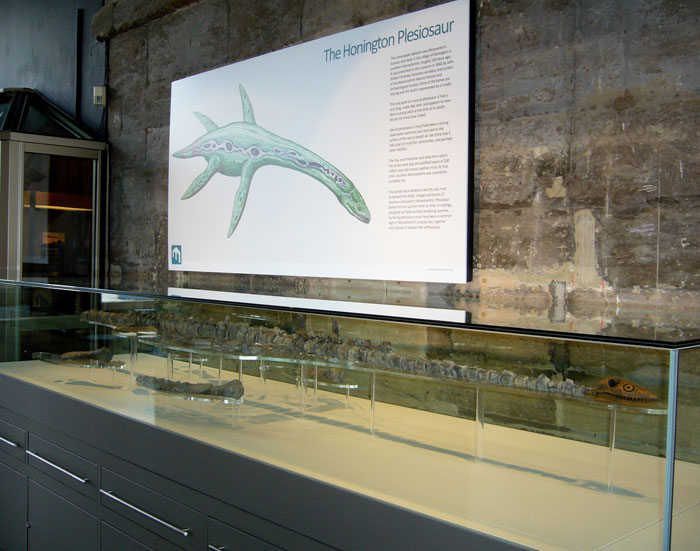The ‘Honington plesiosaur’ goes on show at Warwickshire Museum
Most museum collections contain hidden treasures, but the Honington plesiosaur in the Warwickshire Museum is one treasure, I’m pleased to say, that is no longer hidden.

I first came across the Honington plesiosaur while working in the geological collection of the Warwickshire Museum under the supervision of Jon Radley, the curator of natural sciences. While in the stores, my beady little eyes couldn’t help but spot the neatly printed name, ‘Plesiosaurus rugosus’, on an unopened dusty box. Upon further inspection we discovered, to our astonishment, an almost complete long-necked plesiosaur skeleton. I took the time to lay out the remains and after a little digging through documentation, we were able to confirm that the specimen originated from Honington, near Shipston-on-Stour, in Southern Warwickshire. The fossil is also well-constrained stratigraphically, which is quite rare for historical specimens of Lower Jurassic plesiosaurs.

The specimen consists of an almost complete postcranial skeleton, but unfortunately lacks any trace of the skull, as is often the case in long-necked plesiosaurs. This is partly because the small skull in plesiosauroids is delicately constructed and prone to damage. Despite the missing cranium, the specimen is noteworthy because it is preserved in three dimensions and is free from matrix. This means it is possible to view and study the bones from all directions and gather proportional data.

Jon and I are in the process of writing up a description of the specimen and assessing its identity and evolutionary significance. In the meantime, the Honington plesiosaur has quite rightly wriggled its way out of storage and onto public display. It’s now exhibited in a beautiful case as part of a recently renovated gallery. I was happy to be able to assist with the Honington display and provided a life-restoration of the animal as a graphic to accompany the new display. A resin replica of a skull representing Plesiosaurus is doing a fine job as a replacement for the missing cranium. The fossil also makes a fitting counterpart to another spectacular marine reptile on show in the gallery, the Wilmcote plesiosaur – a beast for a future blog entry perhaps? So if you’re in the region, do drop in!

That isn’t the Favorite Plesiosaurus skull is it, Adam…? I just noticed the colour!
That’s a lovely display by the way – reminds me very much of the one built for the Lincoln plesiosaur. Always good to be able to visit a museum and see a plesiosaur in 3D.
I thought I recognised the illustration as yours. 🙂 I was about to go and check in the gallery until you confirmed it.
@Marc Yes, it’s the Favorite Plesiosaurus skull, as recommended by yours truly. It is probably a touch too small but does the trick at a rather reasonable price. I must review it on the dinotoyblog some day.
@Niroot Glad you recognised it. The only difference is that I colourised the illustration for the display. Oh, and it is mirrored – the original faces to the left.
I did visit the gallery eventually anyway and saw the differences. Was it digitally coloured? *Braces self* 😉
Yes, Photoshop! 🙂
@Adam Hang on…when did I recommend it? I can just remember you commenting on its faults (lack of braincase?)…
Wait…’youRS TRULY’. Long day, long day…
🙂 Yeah, I recommended it despite the lack of a braincase.